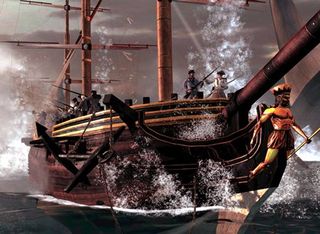That said, the power of artillery does make long-range warfare a more significant part of the expert player’s repertoire. Heavier cannons and mortars can’t be easily moved, andso must be cunningly placed, but horse-drawn artillery outpaces infantry. These light guns can flank otherwise solid enemy formations, raining fire down before harnessing up and scampering to another firing position. Armies adapted the use of horses to the changing battlefield: this is also the age of dragoons. As mounted soldiers, they have the speed to outmaneuver the enemy and the firepower to cause serious casualties when they dismount. When the lumbering enemy infantry are finally ready to fire at them, the dragoons can remount and retreat out of range, or continue to outflank. Meanwhile, your infantry can advance relatively safely on the distracted enemy.
Such tactics, says Jamie Ferguson, reflect battles of the time. “If a player uses tactics they’ve read about from Napoleon’s or Nelson’s battles, they’re likely to produce results. Someone who knows about these areas of military history will probably have an advantage.” The increased importance of cover and buildings on the battlefield means CA have had to work hard at making computer-controlled generals more cunning opponents. One member of the team has this as his sole job.
Early details about Empire’s campaign map - coupled with the historical fact that countries didn’t often wipe out other countries and steal all their land in this era - led us to suspect we’d be playing a very different type of game. No more painting the map your faction’s colour, we’d thought. In fact, says James, the formula is not too different. “You’re still sending armies out and capturing territory. Depending on which nation you choose, however, you’ll have very different starting objectives. Some will start with a couple of simple home territories, others will have the beginnings of an empire, for example in North America. You absolutely can still charge around turning the map your colour. What we’ve tried to do, though, is up the challenge and provide options.”

Jamie Ferguson fills in the details. “We’ve taken all the structures that you’d previously built in a city out of that ‘container’ and made towns around the region. This means that a player can easily see, from the campaign map, what a region holds, and also attack or sabotage individual things - docks, farms, etc.” It’ll be more obvious how valuable a region is, and what the effects of attacking it will be. You won’t have to take out the region’s city to seriously hamper your enemy: you can cut off supply lines, trade, docks and industry without tackling the main city. “We still have capital cities, though, and sieges are still in the game, but depending on where you are it’ll be harder to hold onto a city than before.” So for example, the English could take Paris if they wanted, but the populace will be very hard to control. Attacking France’s infrastructure will be easier and be more effective strategically.
As for your overall objectives, it won’t be the previous Total War style of conquering a set number of territories before declaring victory. Creative Assembly wouldn’t be pressed on exactly what a given nation’s objectives might be, but think in terms of what those countries were aiming for at the time: successful colonies, trade routes and dominance in certain regions. “We don’t want players to try to recreate exactly what a particular nation did at the time,” says Jamie, “but your goals and opportunities will reflect what really happened.”
The 18th century saw a shift in power from monarchs and the aristocracy towards politicians and the people. So no more kings lording it over the battlefield, we thought, no more assassins and spies trailing after the men in big hats, no more princesses, priests and shady characters wandering the map. For once, we were actually close to the mark. Generals will no longer be drawn from a family tree: army commanders are professional and as a result are recruited; though there’ll be a limited number you can have at once. However, these men will be every bit as heroic and characterful as any previous suspiciously-chinned prince. Traits and retinues will be limited in number (eliminating the confusing lists of Medieval II) and thus clearer; names will be more varied. In fact, some characters will be historical; not only real generals and admirals to lead your forces, but also inventors and politicians to improve city life.
For all the splendor of the battle screens, it’s on the campaign map - screenshots of which CA are keeping under lock and key until the summer - where they’re hardest at work. James Russell feels there’s a lot to address: “We’ve looked carefully at what the player spends their time doing. Too much time in the past was spent on managing tax rates and assembling armies, so we’ve streamlined that.” You will be able to construct armies and fleets around generals and admirals; the units you want will be built at the nearest possible place and move as quickly as they can to join up with their leader. As obsessive builders of ‘perfect’ armies ourselves, we can’t calculate the micromanagement time this will save us.
